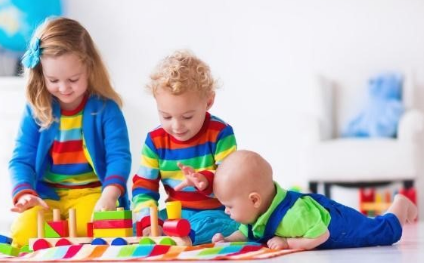Latest Announcements

Age grouping of children and a positive slant on how the ratios for two-year-olds can work
October 12, 2023
By: Jo Caswell and Kate Peach, Founders, Peachwell Early Years Consultancy
As the revised EYFS framework comes into
play, and providers have the choice to operate on a 1-to-5 ratio for
two-year-olds, there is much discussion amongst professionals as to whether
this is right or not. Many argue an increased ratio compromises on quality.
That may well be correct in some situations. We would never condone any form of
reduced quality, or suggest any approach that may limit the care and learning
experiences offered to children. However, we can speak from personal experience
about how the complex needs of two-year-olds can be better met within the
sector with some quite radical mindset changes.

Traditionally, many nurseries operate
their settings by age grouping children - 0-2s, 2-3s, and 3-4s. This sits
perfectly with the requirements of the EYFS statutory framework ratios. But is
this suitably meeting the needs of all age groups? We often see the
developmental needs of two-year-olds are not always fully understood and
catered for. In this typical grouping structure, children of a very narrow,
sometimes challenging, developmental stage are grouped together with limited
opportunities for them to learn from older, more socially experienced children.
This means, often, two-year-olds copy, or are victims to, the typical
behavioural traits of biting, hitting or the consequences of limited language
and frustration.
As professionals, we often underestimate
the abilities of two-year-olds and what they are capable of. They can sometimes
be the 'lost' age group - they neither fit the 'babies' nor traditional 'pre-school' age. But, in our experience, when two-year-olds are cared for
alongside older children, the progression in their behaviour and development is
much quicker. Many providers steer clear of mixed age groupings, considering
these too difficult to manage, or complicated to staff in terms of ratios. It
is often more cost effective to operate on the traditional groupings already
mentioned. But, as we say, this is not always meeting the two-year-olds needs.
In our experience, when two-year-olds are
cared for alongside older children, the development of language, social skills,
interest, and curiosity is far more rapid. Of course, it takes careful planning
and organisation. Risk assessments need to be completed to ensure the learning
environment and group activities are safe. You cannot expect two-year-olds to concentrate
at the same level of four-year-olds and staff must have realistic expectations.
With careful organisation, the benefits, we feel, far outweigh any negatives.
Two-year-olds thrive in the company of older friends. They copy their actions
and are inspired by their behaviour. Older children learn important skills
around social development and being kind and showing empathy towards the needs
of younger children.

A mixed age group approach is not as scary
and impossible to manage as it may first sound. Firstly, the revised staffing
ratio is easier to adopt. We have had feedback from many clients who confirm
they can operate easily with the revised ratio without compromising on quality.
It just takes careful planning and a workforce who fully understand the
developmental needs, and abilities of two-year-olds. This is vital.
Strangely, we do not question how we meet
the diverse developmental needs of babies in a typical baby room. Yet, the
abilities of babies aged six months to those aged 23 months are vast. However, the
sector sometimes has an issue and avoids potentially mixing children aged 35
months with those aged 37 months - a much narrower, easier-to-manage
developmental phase.
Is it time to re-think what we
traditionally do? We say 'yes'. Give it a go, it works.

As professionals, we often underestimate
the abilities of two-year-olds and what they are capable of. They can sometimes
be the 'lost' age group - they neither fit the 'babies' nor traditional 'pre-school' age. But, in our experience, when two-year-olds are cared for
alongside older children, the progression in their behaviour and development is
much quicker. Many providers steer clear of mixed age groupings, considering
these too difficult to manage, or complicated to staff in terms of ratios. It
is often more cost effective to operate on the traditional groupings already
mentioned. But, as we say, this is not always meeting the two-year-olds needs.
In our experience, when two-year-olds are
cared for alongside older children, the development of language, social skills,
interest, and curiosity is far more rapid. Of course, it takes careful planning
and organisation. Risk assessments need to be completed to ensure the learning
environment and group activities are safe. You cannot expect two-year-olds to concentrate
at the same level of four-year-olds and staff must have realistic expectations.
With careful organisation, the benefits, we feel, far outweigh any negatives.
Two-year-olds thrive in the company of older friends. They copy their actions
and are inspired by their behaviour. Older children learn important skills
around social development and being kind and showing empathy towards the needs
of younger children.

A mixed age group approach is not as scary
and impossible to manage as it may first sound. Firstly, the revised staffing
ratio is easier to adopt. We have had feedback from many clients who confirm
they can operate easily with the revised ratio without compromising on quality.
It just takes careful planning and a workforce who fully understand the
developmental needs, and abilities of two-year-olds. This is vital.
Strangely, we do not question how we meet
the diverse developmental needs of babies in a typical baby room. Yet, the
abilities of babies aged six months to those aged 23 months are vast. However, the
sector sometimes has an issue and avoids potentially mixing children aged 35
months with those aged 37 months - a much narrower, easier-to-manage
developmental phase.
Is it time to re-think what we
traditionally do? We say 'yes'. Give it a go, it works.


1 Comments
Hayley Hone
13-Oct-2023
Great blog. Gave me lots to think about!